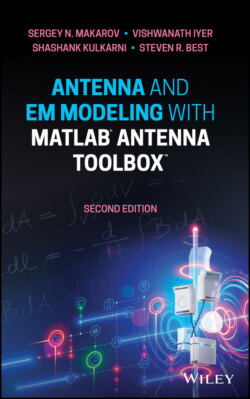Читать книгу Antenna and EM Modeling with MATLAB Antenna Toolbox - Sergey N. Makarov - Страница 46
PROBLEMS
Оглавление1 1. An antenna withΖa = 100 ΩΖa = 100 Ω − j100 ΩΖa = 100 Ω + j100 Ωis directly connected to a generator with Rg = 50 Ω. Determine the reflection coefficient Γ of the antenna, its magnitude, and normalized power delivered to the antenna in every case.
2 2. Repeat Problem 1 ifa quarter wave transmission line with Z0 = 70.7 Ω is added to the antenna;a full wave transmission line with Z0 = 70.7 Ω is added to the antenna.
3 3. If an antenna is either an open or short circuit, what is its reflection coefficient, Γ? Hint: The problem may be solved using the currents associated with the reflected and forward waves in Eq. (1.18), but introducing a minus sign to account for the opposite orientations of the two currents: .
4 4. Repeat Problem 3 ifa quarter wave transmission line with Z0 = Rg is added to the antenna;a full wave transmission line with Z0 = Rg is added to the antenna.
5 5. The exact values of the antenna reflection coefficient Γ (computed vs. characteristic impedance of a 50 Ω transmission line) are0.1;0.316;−0.5.Determine the reflection coefficient values in dB.Determine antenna impedance.
6 6. Calculate and plot to scale the phase of the reflection coefficient in Example 1.10.
7 7. In Example 1.10, a coaxial transmission cable RG‐58 with Ζ0 = Rg = 50 Ω and with the length of 1 m is added to the antenna. How does the plot in Figure 1.8 change?
8 8. The lower frequency of an antenna band is 2.5 GHz; the upper frequency of the band is 6 GHz. Determine the band center frequency and the antenna impedance bandwidth.
9 9. In Example 1.10, we use a generator with Rg = 100 Ω. How does the antenna impedance bandwidth will change?
10 10*. A thick cylindrical tubular dipole has lA = 15 cm, a = 5 mm. Using MATLAB Antenna Toolbox, determine the center frequency of the band and the impedance bandwidth percentage. How do those values relate to the values found in Example 1.10?
11 11*. Browsing the Antenna Toolbox Classes, provide at least one example of an antenna that has a significantly larger bandwidth than a thin dipole of the same length when matched to a 50 Ω generator/transmission line. Justify your answer by numerical simulations.
12 12*. A quantity that is also often used in analyzing the port characteristics of an antenna is return loss. What is it? How is it different from the reflection coefficient? Use the MATLAB Antenna Toolbox to plot the return loss and the reflection coefficient of a dipole antenna as described in Problem 10. Comment on the results.
13 13*. Your boss at the startup you have joined tells you about this new antenna that has been designed and called an ESD – an electrically small dipole. Your boss claims that the spatial radiation characteristics (far‐field directivity/gain) do not change as the operating frequency is lowered. Investigate this claim by using the dipole in the MATLAB Antenna Toolbox library, modifying it as per the dimensions in Problem 10 and analyzing at the following frequencies: 200, 150, and 100 MHz. Do the following:Calculate and plot the 3D radiation pattern of the antenna at the listed frequencies and make a table of the maximum directivity reported in the plot (look at top‐left corner).Tabulate the impedance of this antenna at the listed frequencies.Comment on the results.
14 14. Is the common household microwave oven an antenna? Justify your answer.
